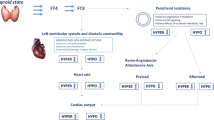Abstract
Rats treated with temelastine (SK&F 93 944), a novel histamine H1-receptor antagonist, develop thyroid lesions characterized by hypertrophy and colloid depletion. To investigate the mechanism underlying the lesion the biliary clearance and hepatocellular accumulation of radio-labelled iodothyronines was measured in rats or cultured rat hepatocytes. Treatment with temelastine increased both the biliary clearance (approximately 300% of control) and hepatocellular accumulation (approximately 200%) of thyroxine (T4) but had little or no effect on tri-iodothyronine (T3). Chromatographic analysis of bile samples from temelastine — treated rats showed that the majority (approximately 78%) of T4 was present in the unconjugated form. This contrasted with data from phenobarbitone — treated rats which showed that approximately 80% of T4 in the bile was present as the glucuronide conjugate. Studies with cultured hepatocytes showed that the hepatocellular accumulation of T4 was energy dependent. At 4° C the treatment — related increases in accumulation of T4 were abolished, suggesting that temelastine is specifically affecting the high affinity, energy dependent system which preferentially transports thyroxine into hepatocytes. Because temelastine is metabolized extensively, investigations were undertaken to discover if the hepatic effects were caused by the parent compound or an oxidative metabolite. The results showed that the hepatocellular accumulation of T4 remained increased in hepatocytes co-incubated with temelastine and 1-aminobenzotriazole (a suicide inhibitor of cytochrome P450), even though no measurable P450 could be found in the cells. Also, in studies with two major “rat” metabolites of temelastine, i.e. 93944-Met I or 93944-Met VIII, treatments failed to reproduce the responses seen with the parent compound. These data suggest that it is the parent compound and not some oxidative metabolite which is responsible for the hepatic effect. It is concluded that temelastine produces the observed thyroid changes by increasing the hepatic clearance of T4, leading to increases in TSH release resulting in hypertrophy of the gland. The increased hepatic clearance of thyroxine appears to be mediated via a novel mechanism not associated with the induction of thyroxine metabolizing enzyme systems.
Similar content being viewed by others
References
Atterwill CK, Poole A, Jones C, Jones R, Brown C (1989) Mechanistic investigations of species-specific thyroid lesions induced by treatment with the histamine H1 antagonist temelastine (SK + F 93 944) in rats. Food Chem Toxicol 27: 681–690
Bastomsky CH, Murthy PVN (1975) Enhanced in vitro hepatic glucuronidation of thyroxine in rats following cutaneous application or ingestion of polychlorinated biphenyls. Can J Physiol Pharmacol 54: 23–26
Berry MN, Friend DS (1969) High yield preparation of isolated rat liver parenchymal cells. A biochemical and fine structural study. J Cell Biol 43: 506–520
Brown CG, Harland RF, Major IR, Atterwill CK (1988) Effects of toxic dose of a novel histamine (H2) antagonist on the rat thyroid gland. Food Chem toxicol 25: 787–794
Colmer CP, Chengelis CP, Levin S, Kotsonis FS (1985) Changes in thyroidal function and liver UDP glucuronyl-transferase activity in rats following administration of a novel imidazole (SC-37 211). Toxicol Appl Pharmacol 80: 420–436
Hasen J, Bernstein G, Volpett E, Oppenheimer JH (1968) Analysis of the rapid interchange of thyroxine between plasma and liver and plasma and kidney in the intact rat. Endocrinology 82: 37–46
Henry EC, Gasiewicz TA (1987) Changes in thyroid hormones and thyroxine glucuronidation in hamsters compared with rats following treatment with 2,3,7-8-tetrachlorodibenzo-p-dioxin. Toxicol Appl Pharmacol 89: 165–174
Krenning E, Docter R, Bernard B, Vissa T, Hennemann G (1981) Characteristics of active transport of thyroid hormone into rat hepatocytes. Biochim Biphys Acta 676: 314–320
Krenning EP, Docter R, Visser TJ, Hennemann G (1983) Plasma membrane transport of thyroid hormone: its possible pathophysiological significance. J Endocrinol 6: 59–65
Mapes JP, Harris RA (1975) Trypan blue dye exclusion test. FEBS Lett 51: 80–83
Mendel CM, Weisger RA, Jones AL, Cavalieri RR (1987) Thyroid hormone-binding proteins in plasma facilitates uniform distribution of thyroxine within tissues: a perfused rat liver study. Endocrinology 120: 1742–1749
Mico B, Federowicz DA, Ripple MG, Kerns W (1988) In vivo inhibition of oxidative drug metabolism by and acute toxicity of, 1-9-aminobenzotriazide (ABT). A tool for biochemical toxicology. Biochem Pharmacol 37: 2515–2519
Omura T, Sato R (1964) The carbon monoxide-binding pigment of liver microsomes. J Biol Chem 239: 2370–2378
Oppenheimer JH, Bernstein G, Surks MI (1968) Increased thyroxine turnover and thyroidal function after stimulation of hepatocellular binding of thyroxine by phenobarbital. Clin Invest 47: 1399–1406
Pliam N.B, Goldfine ID (1977) High affinity thyroid homone binding sites on purified rat liver plasma membranes. Biochem Biophys Res Comm 19: 166–172
Poole A, Jones RB, Pritchard D, Catto L, Leonard T (1989) In vitro accumulation of thyroid hormones by cultured rat hepatocytes and biliary excretion of iodothyronines in rats treated with a novel histamine H2-receptor antagonist. Toxicology 59: 23–36
Rao GS (1981) Mode of entry of steroid and thyroid hormones into cells. Mol Cellular Endocrinol 21: 97–108
Sanders J, Eigenberg DA, Bracht LJ, Wang WR, Zweiten MJ (1988) Thyroid and liver trophic changes in rats secondary to liver microsomal enzyme induction caused by an experimental leukotriene antagonist. Toxicol Appl Pharmacol 95: 378–387
Sormachi K, Robbins J (1978) Uptake and metabolism of thyroid hormones by cultured monkey hepatocarcinoma cells. Effects of potassium cyanide and dinitrophenol. Biochim Biophys Acta 542: 515–526
Takai NA, Rapoport B, Yamomoto M (1980) Biliary excretion of iodothyronines in rats determined by high pressure liquid chromatography. Effect of starvation. Endocrinology 107: 176–182
Author information
Authors and Affiliations
Rights and permissions
About this article
Cite this article
Poole, A., Pritchard, D., Jones, R.B. et al. In vivo biliary excretion and in vitro cellular accumulation of thyroxine by rats or cultured rat hepatocytes treated with a novel histamine H1-receptor antagonist. Arch Toxicol 64, 474–481 (1990). https://doi.org/10.1007/BF01977630
Received:
Accepted:
Issue Date:
DOI: https://doi.org/10.1007/BF01977630




